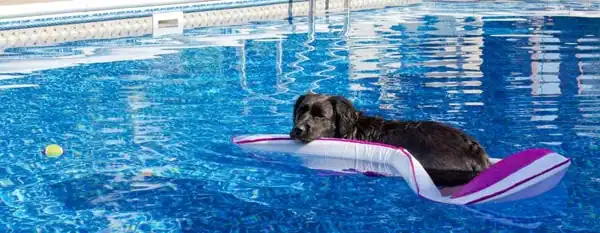Everyone wants to let their dog get in on the summertime fun with the rest of the family. But can Dogs swim in a saltwater pool?
Dogs can swim in saltwater pools, but there are some precautions that need to be taken. While Saltwater pools contain a fairly low concentration of salt, if your dog tends to ingested a lot of water while swimming you need to monitor the situation.
To ensure the safety of both the dog and the pool, it is recommended to consult with a veterinarian before allowing a dog to swim in a saltwater pool. A life vest can also be used to provide additional safety for dogs who are not strong swimmers.
Is It Okay for Dogs to Swim in a Saltwater Pool?
Dogs are natural swimmers and love to spend time in the water. Many pet owners wonder if they should let their dogs swim in a saltwater pool. Saltwater pools are becoming increasingly popular because they are easier to maintain and provide a more natural swimming experience.
Just as a low concentration of saltwater can feel better on your own skin than a pool with added Chlorine, that same water can be fine on a dog’s skin. However, it is important to consider some safety tips before allowing any dogs to swim in a saltwater pool … or any other body of water for that matter.
Saltwater pools contain salt, which can be harmful to dogs if ingested in large quantities. Dogs may also experience skin irritation if they spend too much time in saltwater. It is important to monitor your dog’s behavior and health while they are swimming in a saltwater pool.
Certain breeds of dogs are better suited for swimming than others. Breeds such as Retrievers, Spaniels, Airedale Terriers and Setters are natural swimmers and enjoy spending time in the water. Breeds such as Bulldogs and Pugs may struggle to swim and probably should not go in the water. Having had dogs all my life, my observation is that water dogs know who they are – they will jump right in. The other dogs will either avoid the water entirely, or they will play only where it is shallow – such as near the steps going into the pool.
And if you have swimming pets, this article talks about salt content in Koi ponds.
The salt content of a saltwater pool is also an important factor to consider. Saltwater pools typically have a lower salt content than the ocean. The salt needed for a salt chlorine generator to work correctly is 2,700 and 3,400 parts per million (ppm). The salt concentration of the ocean is roughly 35,000 ppm, or over 10 times as much.
It is recommended to consult with a veterinarian before letting your dogs swim in a saltwater pool. They can provide valuable advice on how to keep your pet safe while swimming. That being said, if you let your dogs swim at the beach (many people do) they should be okay in your pool with proper supervision and care, as we explain below.

Benefits of Letting Dogs Swim in a Saltwater Pool
Swimming is a great exercise for dogs, providing numerous benefits for their physical and mental health. Here are some benefits of swimming for dogs:
Low-impact Exercise
Swimming is a low-impact exercise that is easy on the joints and bones of dogs. It is especially beneficial for older dogs and dogs with arthritis or other joint problems that may find it difficult to exercise on land. Swimming helps to build and maintain muscle mass, improve flexibility, and reduce stiffness.
Cardiovascular Health
Swimming is an excellent cardiovascular exercise that can help improve the heart and lung function of dogs. It can also help lower blood pressure and reduce the risk of heart disease and stroke.
Weight Management
Swimming is a great way to help dogs maintain a healthy weight. It is a calorie-burning exercise that can help dogs lose excess weight and prevent obesity. Swimming also helps to tone muscles and improve body composition.
Mental Stimulation
Swimming provides mental stimulation for dogs, which can help reduce boredom and anxiety. It also helps to improve their mood and overall well-being. Some dogs really get a great amount of enjoyment from jumping in the water, retrieving toys and all the interaction involved.
Oh wait! Those are probably similar to the benefits of you swimming in your pool.

Risks of Letting Dogs Swim in a Saltwater Pool
Saltwater pools are a popular choice for many dog owners who want to give their pets a refreshing swim during hot summer days. However, swimming in saltwater pools can pose several risks to dogs that owners should be aware of.
Salt Content
Saltwater pools contain a higher concentration of salt than freshwater pools or most natural bodies of water other than the ocean. Dogs that ingest too much saltwater while swimming can suffer from salt poisoning, which can cause vomiting, diarrhea, seizures, and even death. Ingesting saltwater can also lead to dehydration, which can be fatal if left untreated. While the salt concentration in your own pool is probably much lower than ocean water, do pay attention to whether your dog or dogs seems to be drinking the water while swimming.
After the dog gets done swimming, pay attention to whether they are trying to drink more water from their bowl than usual. This can be a sign that they drank too much salt water.
Toxicity
Saltwater pools are sometimes treated with chemicals to keep the water clean and safe for swimming. These chemicals can be toxic to dogs if ingested or absorbed through the skin. If you have recently needed to add any chemicals such as algaecides or clarifiers, you should probably keep dogs out of the pool until they have dissipated. That goes for you and the kids, too.
Skin Irritation
The salt content in saltwater pools can possibly cause skin irritation in dogs, especially those with sensitive skin or allergies. Saltwater can dry out a dog’s skin and coat, leading to itching, flaking, and redness, so watch for any signs of skin irritation. It is a good idea to rinse dogs off with fresh water from the hose after they are done swimming.
Dehydration
Swimming in saltwater can cause dogs to lose more water through their skin and mouth than they would in freshwater. This can lead to dehydration, which can be dangerous if left untreated. Signs of dehydration in dogs include dry mouth, sunken eyes, lethargy, and loss of appetite.
Preparing Your Dog for Swimming in a Saltwater Pool
Before letting your dogs swim in a saltwater pool, there are a few things you should do to prepare your furry friend for a safe and enjoyable experience. This section covers grooming, training, and the use of a life vest.
Grooming
Proper grooming is essential to keep your dog’s coat and skin healthy. Before swimming in a saltwater pool, make sure your dog’s coat is clean and free of tangles or mats. It’s also important to trim your dog’s nails to prevent them from getting caught in the pool’s drain or skimmer.
After swimming, rinse your dog’s coat with fresh water to remove any salt and chlorine residue. You can also use a dog-specific shampoo to prevent dryness and irritation.
Training
Not all dogs are natural swimmers, and some may need training before they feel comfortable in the water. Start by introducing your dog to shallow water and gradually increase the depth as they become more confident. Don’t ever force a dog into the water or throw them in. As I mentioned before, dogs know if they want to be in the water or not.
Teach your dog to enter and exit the pool safely, and never leave them unattended in the water. It’s also important to teach your dog basic commands, such as “come” and “stay,” to ensure they listen to you while swimming. If you are in the pool, dogs tend to be much more interested in joining the fun.
If you have very young dogs, be extra careful! A puppy may follow an older dog into the water and quickly get in trouble!
Dog Life Vests

Even if your dog is a strong swimmer, a life vest can provide an extra layer of safety in the water. Choose a vest that fits your dog properly and has a handle on the back for easy lifting.
A life vest can also help your dog stay afloat if they become tired or disoriented in the water. However, it’s important to remember that a life vest is not a substitute for supervision and training.
Other Considerations for Dogs in Saltwater Pools
When it comes to swimming in saltwater pools, dogs can enjoy the water just like humans. Realize that when dogs swim in a saltwater pool, you may have a bit more pool maintenance.
Filtration System
The filtration system of your saltwater pool may need more frequent cleaning or replacement of filter cartridges with the added dog fur or hair that is introduced to the system.
Pool Liner
The pool liner is another important consideration when it comes to dogs and saltwater pools. Dogs have sharp claws that can easily puncture or tear a pool liner, which can lead to leaks and other issues. Training dogs to enter and leave the pool in a safe spot, such as a stair area can save wear and tear on your pool liner.
You may also want to consider using a pool cover when the pool is not in use to keep dogs from going for a swim when you aren’t watching. That probably is a good thing to say about kids (or neighbor kids) too.
Final Thoughts
While it’s perfectly okay to let dogs swim in a saltwater pool, you have to take certain precautions to ensure their safety. Owners should consider their dog’s breed, age, and swimming ability before allowing them to swim in a saltwater pool. Some breeds, such as retrievers and spaniels, are natural swimmers, while others may struggle in the water.
With proper precautions and supervision, dogs can safely enjoy swimming in a saltwater pool. However, it is important for owners to be knowledgeable about the risks and take steps to ensure their pet’s safety.
Photo of dog jumping into a pool by Blue Bird.







